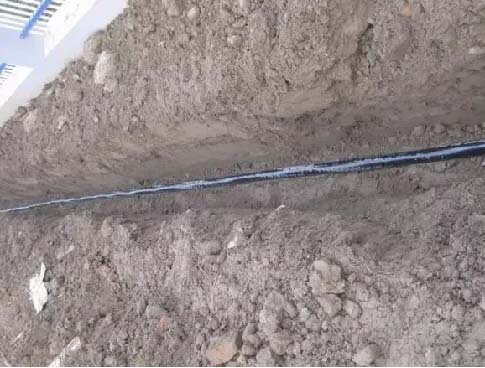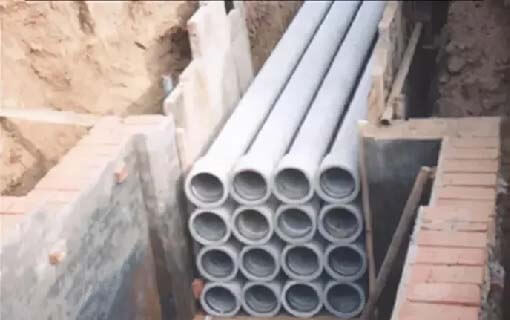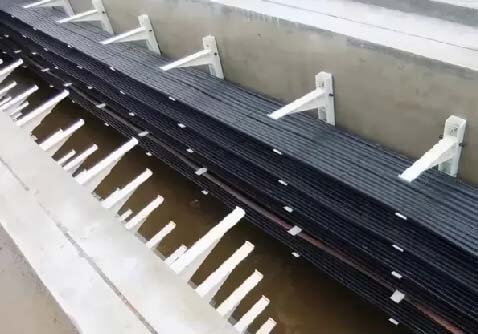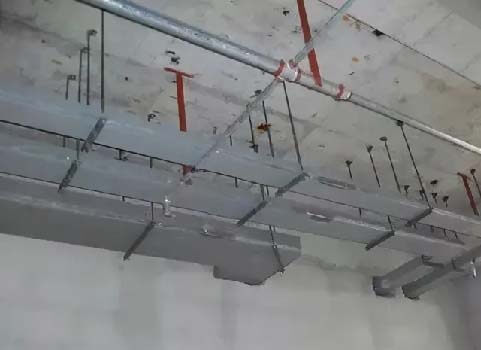13
Dec
Four methods of cable laying
Share:
There are generally four ways to lay cable lines: direct buried cable laying, pipe cable laying, cable laying in cable trenches or tunnels, and bridge cable laying. The construction points for these four laying methods are summarized as follows.
1. Direct burial

(1) The bottom of the excavated trench must be a soft soil layer. If there are stones or hard debris, a 100mm thick layer of soft soil or sand must be laid. If the soil around the cable contains corroded metal sheathing of the cable, it should be removed and replaced with soil. The burial depth should be no less than 0.7m, and the burial depth should be no less than 1m when crossing farmland. When leading into buildings, intersecting with underground buildings, and bypassing underground buildings, they can be buried shallowly, but protective measures should be taken. The cables should be buried below the frozen soil layer. When conditions are restricted, measures should be taken to prevent the cables from being damaged. measure.
(2) After the cable is laid, 100mm thick soft soil or fine sand should be laid on it, and then covered with a concrete protective board. The coverage width should exceed 50mm on both sides of the cable, or bricks should be used instead of concrete protective boards.
(3) There should be a cast iron or concrete protective box outside the intermediate joint box.
(4) A concrete foundation plate should be padded under the joint, and the length should extend 600~700mm from both ends of the joint protection box. When the cable is introduced from the trench into tunnels, manholes and buildings, it must be threaded in the pipe and the pipe opening should be blocked. , to prevent water seepage.
(5) Cables cross each other, cross with non-thermal pipes and pipelines, and when crossing roads and walls, they must be worn in protective tubes. The length of the protective tube exceeds the intersection point by 1m, the clear crossing distance should not be less than 250mm, and the inner diameter of the protective tube should not be Less than 1.5 times the outer diameter of the cable.
(6) Directly buried cables generally use armored cables. Both ends of the metal sheath of the armored cable must be reliably grounded, and the grounding resistance must not be greater than 10Ω.
(7) For directly buried cables, obvious orientation signs or stakes should be set up every 50 to 100m in the straight section, at cable joints, corners, and entering buildings, etc.
(8) The minimum clear distance between cables and other pipelines, roads, buildings, etc. when parallel and crossing should comply with the regulations. It is strictly prohibited to lay cables in parallel above or below the pipeline.
2. Pipe discharge

(1) Cable pipe laying
1) Cable pipes can be made of steel pipes, plastic pipes, ceramic pipes, asbestos cement pipes or concrete pipes, but the inside of the pipe must be smooth;
2) Arrange the pipes in a certain form according to the required number of holes. The pipe joints should be staggered and poured into a whole with cement. They are generally divided into 2, 4, 6, 8, 10, 12, 14, 16 holes, etc.;
3) The aperture should generally be no less than 1.5 times the outer diameter of the cable, the aperture of the pipe for laying the power cable should be no less than 100mm, and the aperture of the control cable should be no less than 75mm;
4) The distance from the top of the buried underground pipe to the ground should be no less than 500mm on sidewalks and no less than 700mm in general areas;
5) Pipe cable wells must be installed at straight-line distances exceeding 100m, at turns and branches of the pipes; the pipes leading to the pits should have a slope of not less than 0.1%, so that the water in the pipes can flow into the pits;
6) Cables laid in pipes should be armored cables.
(2) Laying of cable protection tubes
Where cables enter buildings, tunnels, pass through floors and walls, and are led from the ground to poles, equipment, outer surfaces of walls or places easily accessible to pedestrians, a section below 2m above the ground and other places that may be subject to mechanical damage should be A protective tube with a certain mechanical strength or a protective cover should be installed. The depth of the protective pipe buried in the non-concrete ground should not be less than 100mm, the length extending out of the building's water slope should not be less than 250mm, and the root of the protective cover should not be higher than the ground.
3. Cable trench or tunnel

(1) Cable arrangement
1) Power cables and control cables should not be configured on the same layer of brackets;
2) High and low voltage power cables, strong current and weak current control cables should be arranged in layers in order. Generally, they should be arranged from top to bottom. However, when voltage cables above 35kV are introduced into the cabinet panel, in order to meet the bending radius requirements, they can be arranged from bottom to top. configuration.
(2) The cable is laid on the bracket
1) The control cable should not exceed 1 layer on the ordinary bracket; the control cable should not exceed 3 layers on the bridge.
2) AC three-core power cables should not exceed one layer on ordinary supports and hangers, and should not exceed two layers on bridges.
3) AC single-core power cables should be arranged on the same side bracket. When arranged in a close-fitting equilateral triangle, they should be firmly tied with straps every lm.
4) The clear distance between cables laid in parallel should meet the design requirements.
5) The clear distance between cables and thermal pipes and thermal equipment should not be less than 1m when laid in parallel. When limited by conditions, thermal insulation protection measures should be taken.
6) After the cable laying is completed, debris should be removed in time and the cover should be covered. If necessary, the gaps in the cover should also be sealed.
4. Bridge

(1) Anti-corrosion treatment should be carried out on the bridge. Generally, the surface of the bridge should be galvanized, plastic-plated, coated with oxidized resin, and painted. In highly corrosive environments, corrosion-resistant materials such as aluminum alloy, plastic, and low-standard stainless steel can be used to make the bridge.
(2) Cables can be laid in a single layer on the tray. Small cables can be fixed on the tray with plastic tapes, and large cables can be fixed with metal clips.
(3) The bridge is provided with a support and hanger every 1.5 to 3m in the horizontal section; a support is provided every 1 to 1.5m in the vertical section; supports and hangers should be set 1m away from tees, crosses and elbows at both ends. Hanger.
(4) When the bridge passes through the expansion joint of the building, a 100~150mm gap should be opened, and grounding bridges should be made at both ends of the gap.
(5) The installation of the bridge should be conducive to the insertion and placement of cables. The bridge should be straightened after installation, and the bridge should be fixed on the bracket with pressing pieces.
(6) The length of the supports and hangers supporting the bridge should be consistent with the width of the bridge and should not be any longer or shorter.
Thus, this is all about methods of cable laying.
1. Direct burial

(1) The bottom of the excavated trench must be a soft soil layer. If there are stones or hard debris, a 100mm thick layer of soft soil or sand must be laid. If the soil around the cable contains corroded metal sheathing of the cable, it should be removed and replaced with soil. The burial depth should be no less than 0.7m, and the burial depth should be no less than 1m when crossing farmland. When leading into buildings, intersecting with underground buildings, and bypassing underground buildings, they can be buried shallowly, but protective measures should be taken. The cables should be buried below the frozen soil layer. When conditions are restricted, measures should be taken to prevent the cables from being damaged. measure.
(2) After the cable is laid, 100mm thick soft soil or fine sand should be laid on it, and then covered with a concrete protective board. The coverage width should exceed 50mm on both sides of the cable, or bricks should be used instead of concrete protective boards.
(3) There should be a cast iron or concrete protective box outside the intermediate joint box.
(4) A concrete foundation plate should be padded under the joint, and the length should extend 600~700mm from both ends of the joint protection box. When the cable is introduced from the trench into tunnels, manholes and buildings, it must be threaded in the pipe and the pipe opening should be blocked. , to prevent water seepage.
(5) Cables cross each other, cross with non-thermal pipes and pipelines, and when crossing roads and walls, they must be worn in protective tubes. The length of the protective tube exceeds the intersection point by 1m, the clear crossing distance should not be less than 250mm, and the inner diameter of the protective tube should not be Less than 1.5 times the outer diameter of the cable.
(6) Directly buried cables generally use armored cables. Both ends of the metal sheath of the armored cable must be reliably grounded, and the grounding resistance must not be greater than 10Ω.
(7) For directly buried cables, obvious orientation signs or stakes should be set up every 50 to 100m in the straight section, at cable joints, corners, and entering buildings, etc.
(8) The minimum clear distance between cables and other pipelines, roads, buildings, etc. when parallel and crossing should comply with the regulations. It is strictly prohibited to lay cables in parallel above or below the pipeline.
2. Pipe discharge

(1) Cable pipe laying
1) Cable pipes can be made of steel pipes, plastic pipes, ceramic pipes, asbestos cement pipes or concrete pipes, but the inside of the pipe must be smooth;
2) Arrange the pipes in a certain form according to the required number of holes. The pipe joints should be staggered and poured into a whole with cement. They are generally divided into 2, 4, 6, 8, 10, 12, 14, 16 holes, etc.;
3) The aperture should generally be no less than 1.5 times the outer diameter of the cable, the aperture of the pipe for laying the power cable should be no less than 100mm, and the aperture of the control cable should be no less than 75mm;
4) The distance from the top of the buried underground pipe to the ground should be no less than 500mm on sidewalks and no less than 700mm in general areas;
5) Pipe cable wells must be installed at straight-line distances exceeding 100m, at turns and branches of the pipes; the pipes leading to the pits should have a slope of not less than 0.1%, so that the water in the pipes can flow into the pits;
6) Cables laid in pipes should be armored cables.
(2) Laying of cable protection tubes
Where cables enter buildings, tunnels, pass through floors and walls, and are led from the ground to poles, equipment, outer surfaces of walls or places easily accessible to pedestrians, a section below 2m above the ground and other places that may be subject to mechanical damage should be A protective tube with a certain mechanical strength or a protective cover should be installed. The depth of the protective pipe buried in the non-concrete ground should not be less than 100mm, the length extending out of the building's water slope should not be less than 250mm, and the root of the protective cover should not be higher than the ground.
3. Cable trench or tunnel

(1) Cable arrangement
1) Power cables and control cables should not be configured on the same layer of brackets;
2) High and low voltage power cables, strong current and weak current control cables should be arranged in layers in order. Generally, they should be arranged from top to bottom. However, when voltage cables above 35kV are introduced into the cabinet panel, in order to meet the bending radius requirements, they can be arranged from bottom to top. configuration.
(2) The cable is laid on the bracket
1) The control cable should not exceed 1 layer on the ordinary bracket; the control cable should not exceed 3 layers on the bridge.
2) AC three-core power cables should not exceed one layer on ordinary supports and hangers, and should not exceed two layers on bridges.
3) AC single-core power cables should be arranged on the same side bracket. When arranged in a close-fitting equilateral triangle, they should be firmly tied with straps every lm.
4) The clear distance between cables laid in parallel should meet the design requirements.
5) The clear distance between cables and thermal pipes and thermal equipment should not be less than 1m when laid in parallel. When limited by conditions, thermal insulation protection measures should be taken.
6) After the cable laying is completed, debris should be removed in time and the cover should be covered. If necessary, the gaps in the cover should also be sealed.
4. Bridge

(1) Anti-corrosion treatment should be carried out on the bridge. Generally, the surface of the bridge should be galvanized, plastic-plated, coated with oxidized resin, and painted. In highly corrosive environments, corrosion-resistant materials such as aluminum alloy, plastic, and low-standard stainless steel can be used to make the bridge.
(2) Cables can be laid in a single layer on the tray. Small cables can be fixed on the tray with plastic tapes, and large cables can be fixed with metal clips.
(3) The bridge is provided with a support and hanger every 1.5 to 3m in the horizontal section; a support is provided every 1 to 1.5m in the vertical section; supports and hangers should be set 1m away from tees, crosses and elbows at both ends. Hanger.
(4) When the bridge passes through the expansion joint of the building, a 100~150mm gap should be opened, and grounding bridges should be made at both ends of the gap.
(5) The installation of the bridge should be conducive to the insertion and placement of cables. The bridge should be straightened after installation, and the bridge should be fixed on the bracket with pressing pieces.
(6) The length of the supports and hangers supporting the bridge should be consistent with the width of the bridge and should not be any longer or shorter.
Thus, this is all about methods of cable laying.
Previous article:




